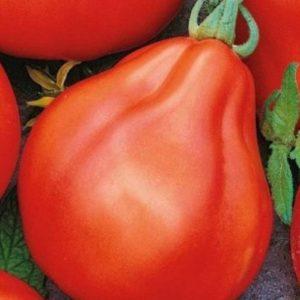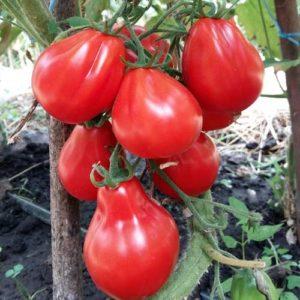We grow a rich harvest of sweet and juicy tomatoes: “Truffle Red” tomato - characteristics and description of the variety
Are you looking for tasty, unpretentious, productive, universal-purpose tomatoes? Then we advise you to pay attention to the Red Truffle variety. The tomato is resistant to diseases, its fruits are fleshy and sweet, and are stored for a long time. Small, original pear-shaped tomatoes look great when preserved and will be a great addition to your favorite dishes. Let's get to know the variety in more detail.
Characteristics and description of the variety

The Red Truffle variety was bred by Russian breeders and belongs to the Siberian tomato collection. It is distinguished by its high quality and has been successfully grown by farmers since 2002.
Distinctive features
Tomato bush Red truffle indeterminate. The height in open ground is 90-100 cm. In greenhouses, the plant height reaches 150-170 cm.
The variety is mid-season in terms of fruit ripening. From the moment of germination to the ripening of the fruit, 105-115 days pass.
Fruit characteristics and yield
Ripe fruits acquire a bright red color and reach 100-170 g. The shape of the fruits is pear-shaped with slightly pronounced ribbing. The pulp is dense, consists of 5-6 seed chambers.
The yield of the variety is above average. 6-8 kg of fruits are collected from one bush. When grown in greenhouses, the yield reaches 15-20 kg per square meter of planting.
How to grow seedlings
Growing seedlings begins with preparing and sowing seeds.
Seed preparation
Tomato seeds are sown both dry and after pre-processing them. To prepare, the seeds are soaked in water with the addition of growth stimulants or antiseptics. This accelerates germination and helps to form stable immunity in young plants.
Container and soil
To grow tomato seedlings you will need two types of containers:
- To plant seeds for germination, use a wooden or plastic container with drainage holes. Make the box yourself or purchase ready-made containers;
- During picking, each plant is transplanted into an individual container. For this, they use both special seedling pots and food containers, plastic or paper cups, and cut-off packages of packaged juice.
Important. When using non-specialized containers, make drainage holes.
Prepare the soil for growing seedlings yourself or buy ready-made soil mixtures. When preparing independently, soil from the beds on which onions, tomatoes, potatoes or bell peppers grew is not used. Land from under cucumbers or cabbage is ideal.
The prepared soil must be frozen twice (freeze, let thaw and freeze again) or calcined in the oven. This will disinfect it and get rid of parasites.
Purchased soil does not require pre-treatment.
Sowing
50-60 days before the expected date of planting the tomato in a permanent place of growth, they begin sowing the seeds. Soil is poured into containers for planting and compacted well. Grooves 1-1.5 cm deep are made on the surface and spilled with water. The distance between the grooves is 3-4 cm.
Seeds are distributed onto a damp surface along the groove and sprinkled with soil on top.The box is covered with film and placed in a warm place. As soon as the first shoots appear from the ground, the film is removed.
Growing and care
After 1-2 leaves appear on the sprouts, begin picking. Picking is transplanting seedlings into individual containers. To do this, use a teaspoon to pry the sprout as deep as possible and transfer it to a separate glass filled with soil. The soil around the plant is well compacted and watered with warm water.
For stable growth, seedlings need a temperature of 20-25 degrees during the day and not lower than 18 degrees at night.
Water the seedlings when the top layer of soil dries out a little. It is preferable to do this in the morning so that the roots have time to absorb excess moisture during the day and do not become hypothermic at night.
1-2 times a month, seedlings are fed with phosphorus-potassium fertilizers.
How to grow tomatoes
Planting seedlings in the ground at the age of 55-65 days. By this time, 5-7 leaves are opening on the plant.
Landing
The plants are not watered 2-3 days before planting. This will make it easier to remove them from the container without damaging the roots.
On the eve of planting, the soil is thoroughly watered with a strong solution for disinfection. potassium permanganate.
Humus, wood ash or vermicompost are added to the planting hole or furrow. Spill 1-2 liters of water. Place the plant in damp soil, cover it with soil and compact it properly. Up to three plants are placed on one square meter.
The plant is not watered for a week after planting, because... The moisture introduced at the time of planting will be sufficient.
Plant care
Let's take a closer look at the process of caring for plants.
Watering
Tomato is a heat-loving plant; it does not like drafts and hypothermia. It is preferable to maintain dry air in the greenhouse. Water plants It’s better to use a watering can with the sprayer removed once a week. During extreme heat and drought, watering is increased.
After the water is absorbed, it is useful to loosen the top layer of soil. This will prevent the formation of a hard crust on the surface of the earth, which injures the delicate stems of plants.
Weeding and loosening
Removing weeds loosens the soil and improves the penetration of oxygen to the roots of the plant.
Stepping and bush formation
Since the variety is indeterminate, the plant stem requires obligatory pinching. The bush grows in 2 stems. To do this, leave the lower stepson, and the rest are broken out.
Advice. It is better to break out the stepsons “on a stump”, leaving 2-3 cm. This will restrain the leaf axil from growing a new stepson in this place.
To avoid breaking and injury to branches, long stems of the plant require obligatory gartering to a support.
Plant nutrition
The main elements needed by the plant for abundant fruiting are nitrogen, potassium, phosphorus and calcium. At different stages of growth, the plant requires different ratios of substances. in fertilizing. For 10 liters of water dissolve in grams:
| Growth phase | Ammonium nitrate | Superphosphate | Potassium chloride |
| 1-2 weeks after landing | 15-20 | 45-50 | 5-10 |
| Before the formation of 3 fruit clusters | 25-30 | 70-80 | 20-25 |
| Until the end of the growing season | 30-40 | 30-40 | 25-30 |
It is important to observe the plant. If foliage growth occurs too intensively and flowers do not form, then the amount of nitrogen (ammonium nitrate) is reduced, and the dosage of potassium and phosphorus (superphosphate) is increased.
Features of cultivation and possible difficulties
The variety is unpretentious and will not cause much trouble in care. Avoid gross mistakes in agricultural technology, and the plant will reward you with a good harvest.
Among the most common errors in care are the following:
- excessive density of plantings;
- waterlogging;
- untimely loosening and weeding;
- increased air humidity in the greenhouse (more than 60%);
- lack of fertilizers and fertilizers.
Diseases and pests
The Red Truffle variety is resistant to nightshade diseases. But if you do encounter problems, these tips will help you overcome them:
- to treat bacterial infections, fungicides of chemical or biological origin are used (bio: Ecosil, Fitosporin; chemical: Ridomil, Bordeaux mixture);
- repel harmful insects Spraying with tinctures of garlic, chamomile or celandine will help;
- Aphids can be easily washed off with a warm soap solution.
The nuances of growing in open ground and in a greenhouse
The Red Truffle tomato can be successfully grown in open ground in the south and central zone, since the variety is resistant to temperature changes. However, growing in a greenhouse in the middle zone will increase yields and reduce the risk of crop loss due to adverse weather conditions. In northern Russia, the variety is grown only in greenhouses.
When growing tomatoes in open ground, the seedlings are hardened off 1-2 weeks before planting. Every day, the seedlings are briefly exposed to cool air and direct sunlight. Start with 15 minutes, then the time spent in the cold is gradually increased. The average temperature for hardening is 12-15 degrees.
Harvesting and application
Tomatoes have decent taste. The fruits are sweet and juicy. Their small size is suitable for whole-fruit canning; the skin of tomatoes does not crack. Due to its high density and meatiness, Red truffle is not used for making pastes and juices.
The harvested fruits can be stored for up to three months without losing their taste. Both ripe and green tomatoes are harvested for ripening.
Advantages and disadvantages of the variety
The advantages of the variety include:
- unusual shape;
- sweet and meaty;
- good keeping quality;
- stable tying;
- high productivity;
- disease resistance.
Among the disadvantages of the variety, we note:
- the formation of a bush requires additional attention;
- obligatory garter of branches;
- demanding on watering.
Other popular varieties of Truffle tomato
In addition to the Red Truffle, breeders have developed several other varieties. For greater convenience and clarity, the varietal differences are presented in the table:
| Tomato variety | Ripening period | Plant height, cm | Direction of use | Fruit shape | Fruit weight, g | Fruit color |
| Red truffle | Mid-season | 90-170 | salad/pickling | pear-shaped, smooth | 100-170 | Red |
| Japanese red truffle | Mid-season | up to 160 | salad/pickling | pear-shaped, ribbed | 100-150 | Red |
| Black truffle | Mid-season | 150-200 | salad/pickling | pear-shaped, slightly ribbed | 100-150 | Brown-red |
| Yellow truffle | Mid-season | 90-170 | salad/pickling | pear-shaped, smooth | 90-150 | Yellow |
| Pink truffle | Mid-season | up to 200 | salad/pickling | pear-shaped, smooth | 100-150 | Crimson |
| Orange truffle | Mid-season | up to 200 | salad/pickling | pear-shaped, ribbed | 100-150 | Orange |
All truffle tomatoes have similar varietal qualities. The main difference between the varieties is the color of ripe fruits and a slight variation in shape.
Farmer reviews
Farmers highly appreciate the Red Truffle variety for its stable fruit set in all weather conditions. In each review, gardeners note the long shelf life of harvested fruits.Some show photos of tomatoes preserved until the new year.
In addition to transportability, the variety has excellent taste. The tomatoes are very sweet, not sour at all, and the cut flesh is fleshy and sugary.
Conclusion
The Red Truffle variety is unpretentious and productive. Suitable for growing both professionals and beginners. If you follow simple rules of agricultural technology, the plant will reward you with a generous harvest. Thanks to the long shelf life, you will delight your family and friends with fresh homemade tomatoes for a long time!